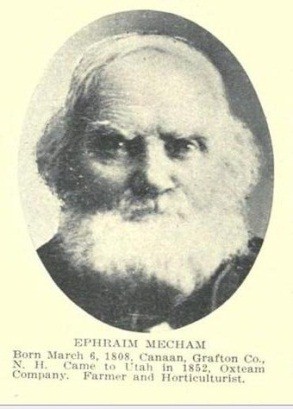The following was received from FamilySearch:

FamilySearch International, Salt Lake City, September 19, 2013 – Meet Ephraim Mecham. On September 10, 2013, this portrait of Ephraim Mecham became the one millionth photo uploaded to FamilySearch.org by contributors! And FamilySearch is pleased to announce with this major milestone that Ephraim’s photo, along with the other million photos, will now be preserved forever for free online at FamilySearch.org.
The Photos and Stories features on FamilySearch.org were introduced to the public on April 16, 2013. Since that time, thousands of people have participated in the exciting process of uploading, tagging, and linking their ancestors’ pictures to the Family Tree, along with their genealogies and stories.
The accomplishment of one million photos highlights the powerful opportunity this website offers. It is unique as one of the largest collections of family history photos in the world. It is completely free, and, most importantly, it offers endless preservation of these photos. Some other features of the website’s photo preservation and sharing services are:
The photos are public and can be seen without signing in. An invitation to see a photo can be shared socially through Facebook, Twitter, Google+, Pinterest, and email. By clicking on a shared link, the visitor is taken directly to the photo for viewing.
If you sign in, you have the option to upload pictures to FamilySearch.org by dragging and dropping them or by browsing your computer or device to locate the photos you’d like to put on the website. You can also upload photos from your smart phone or tablet-any device with an Internet connection.
You have the ability to tag all individuals in a photo (or indicate who they are). Once a photo is tagged, you are able to link individuals in the picture to their profiles in an online family tree. If a person in a family tree has more than one picture in his or her profile, you can also choose which picture is the default one on his or her personal page. This default photo is the one that visitors will see first. If a photograph has many people in it, you can tag each individual and use it for their own profile pages.
Each photo can be given a title of up to 255 characters and a description of up to 4,000 characters, which are entered under the details of the photo. Your username will be associated with the uploaded photo, and you never know what impact you’ll have. Ninety-year-old Lois contacted a contributor of a family photo in her FamilySearch family tree and discovered a distant relative. In return, he has shared information with her that she never knew before.
As your photo collection grows, you can organize photos into albums according to families, individuals, or whatever works best for you. Maybe you have photos of people you’re having trouble identifying. Why not put them in an album labeled “help me identify” or “unknown relatives”? Nanette recently scanned and uploaded the photos from her great aunts’ collections. She was not able to identify everyone in the pictures. After a week or so, she was amazed to find that others online were able to correctly identify the unknown people in the photos right there on the website.
As you view photos of people in your collection, you can see who they are related to: parents, spouse, and children.
Currently, photos are limited to five megabytes (5 MB) in size, but photo size is planned to be expanded in the coming months.
Photo type is limited to JPEG and PNG, but it is anticipated other file formats will be accepted soon.
You can publish and preserve thousands of family photos for free.
Here’s how to get started. First, you’ll want to see what pictures are online of your ancestors. Go to the FamilySearch.org website, and click Photos at the top of the page. Click the blue banner that says Find photos of your ancestors. A page with photos will come up. Photos with a gold banner across the bottom right corner indicate photos added by others. These are your relatives!
Now it’s your turn to upload photos. If you don’t have a traditional scanner, you can use your cell phone. Just take a picture of your family photos, use the browser on your phone, and go to FamilySearch.org. Then click on Photos, and proceed from there.
If you know photos that exist of your ancestors but belong to other family members, contact these relatives and ask them to publish the photos to your family’s tree, or set a date to scan or take pictures of their collection. You can also send out a request for family photos over social media to your relatives. If there are family heirlooms (photos, furniture, bric-a-brac, letters, mementos, medals), take pictures of them and upload the photos to the profiles of your ancestors in the family tree. Then stories can be added by anyone to support the photos and describe them. These photos and stories will become keepsakes for everyone to have and will be preserved freely for future generations.
Once your pictures are uploaded, they will be preserved forever. Every photo is backed up with a redundant system and preserved in state-of-the-art archive facilities. Each ancestor’s photo will now be available to every descendant that individual has or will ever have.
If you have a desire to preserve your ancestors’ photos, it has never been easier. It is fun family history! Here is an opportunity and way to get started. You’ll have it done sooner than you think. Visit FamilySearch.org today. Your family pictures can be part of the next million photos on FamilySearch.org!